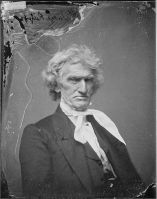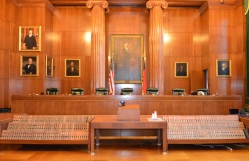Henry Frye’s portrait was unveiled at the North Carolina Supreme Court last Tuesday afternoon. It will be hung in the courtroom, as portraits of every other North Carolina Chief Justice have been since Chief Justice Ruffin’s was put up in 1858.
 Chief Justice Thomas Ruffin was among the most distinguished North Carolinians of his day. He was a jurist of the first rank. Authorities such as Chief Justice William Howard Taft and Justice Felix Frankfurter ranked him as a pioneer in adapting the English common law to the quasi-frontier conditions in the United States.His decisions were followed more than any others by the southern and western courts. Roscoe Pound rated him one of the ten foremost jurists in the United States.
Chief Justice Thomas Ruffin was among the most distinguished North Carolinians of his day. He was a jurist of the first rank. Authorities such as Chief Justice William Howard Taft and Justice Felix Frankfurter ranked him as a pioneer in adapting the English common law to the quasi-frontier conditions in the United States.His decisions were followed more than any others by the southern and western courts. Roscoe Pound rated him one of the ten foremost jurists in the United States.
Today though, Justice Ruffin is most often remembered for his opinion in State v. Mann (1829), on the incidents of slavery. In short, he concluded that a slaveholder was not liable for abusing an enslaved person and was within his rights to beat a slave savagely without cause. Contemporary scholars have concluded that Ruffin, himself a slaveholder and at one time a slave trader, was actively seeking to protect the institution of slavery in State v. Mann and other opinions, and was, in his personal life, a cruel slave master.

Justice Ruffin’s is the earliest portrait in the courtroom. Justice Frye’s will become the latest.
Speakers last Tuesday (Chief Justice Martin, Governor Hunt, US Court of Appeals Judge Wynn, and Jim Williams), celebrated Chief Justice Frye as one of the most distinguished North Carolinians of his day, and also a first rank jurist.
Henry Frye is North Carolina’s first African American Chief Justice. He was the first African American member elected to the North Carolina General Assembly in the 20th Century. He is a champion of voting rights for African Americans and disenfranchised people; and Tuesday’s speakers universally affirmed that, in his person, Henry Frye is a gentle man.
Esse quam videri. Ruffin and Frye.





 />i
/>i
